A Better Tacoma: Stories from 2030
What does taking action on climate change mean for our daily lives? To illustrate what achieving climate actions and working towards our 2030 Strategies will mean for our communities, the following Stories are snippets of 2030 life in Tacoma. Actions to be completed by 2024 are referenced throughout the Stories.
These Stories are fictional. While we hope you find characters in the Stories relatable, any resemblance to real people is coincidental. For more information about specific actions, visit the linked action reference numbers.
STORY 1: MORNING COMMUTE
Dolores is just clearing the breakfast plates into the compost bin (24) when she checks the clock. The school bell will ring in 15 minutes, it’s time to get Nadine on her way to class. Dolores helps her wheel her bike off of the porch and down the front path, gives a quick hug, and watches her ride down the block to meet her friends. The trees planted (18) by a crew of forest stewards
(33) cast a cool shade on Nadine and her classmates as they take the path to school (9).
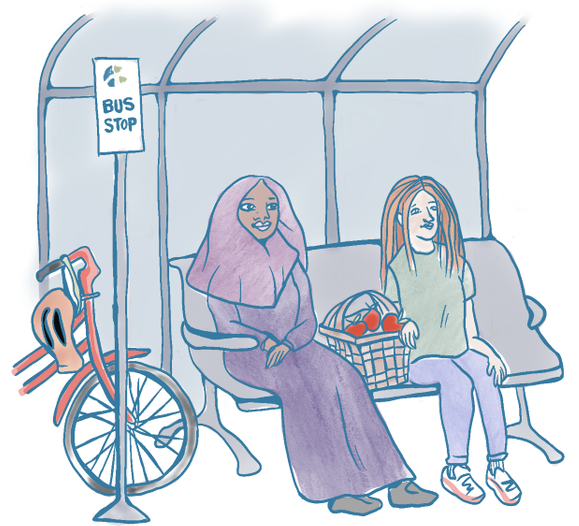
Assured her grand-daughter will make it safely there on time, Dolores heads back inside to prepare for her own commute. Double-checking to make sure she has loaded cash onto her reduced fare ORCA card, she heads out the back door of their duplex. At the end of the alley, Dolores crosses the protected bike lane (12) and joins several others at the bus stop (11). She missed her usual bus this morning but the next one arrives in 8 minutes (10) so she won’t be late to work. While she waits, Dolores sees her neighbors cross the road heading towards the car share station (20, 21). She calls out and waves.
They hold up their picnic gear in response and call back, “We’re heading to the mountains!” Dolores starts to reply, wondering which trail they will be hiking this time, but is cut off by the noiseless arrival of her bus (19). Dolores guides her walker up the bus ramp and finds her seat.
STORY 2: LUNCH WITH FRIENDS
Andrea sets the last box of apples down on the counter, wipes their brow, and peels off their work gloves. They have spent the morning gleaning fruit from right-of-way trees (40) around town and delivering them to restaurants (24). This is the last stop and Andrea is ready for lunch. They peek out into the dining room and smile. Jo is already seated at a table for their lunch date!
“María will be here in a minute, she’s just getting off the Link (11) from campus,” says Jo as they pick up their menus.
“How’s your new apprenticeship (32) going?”
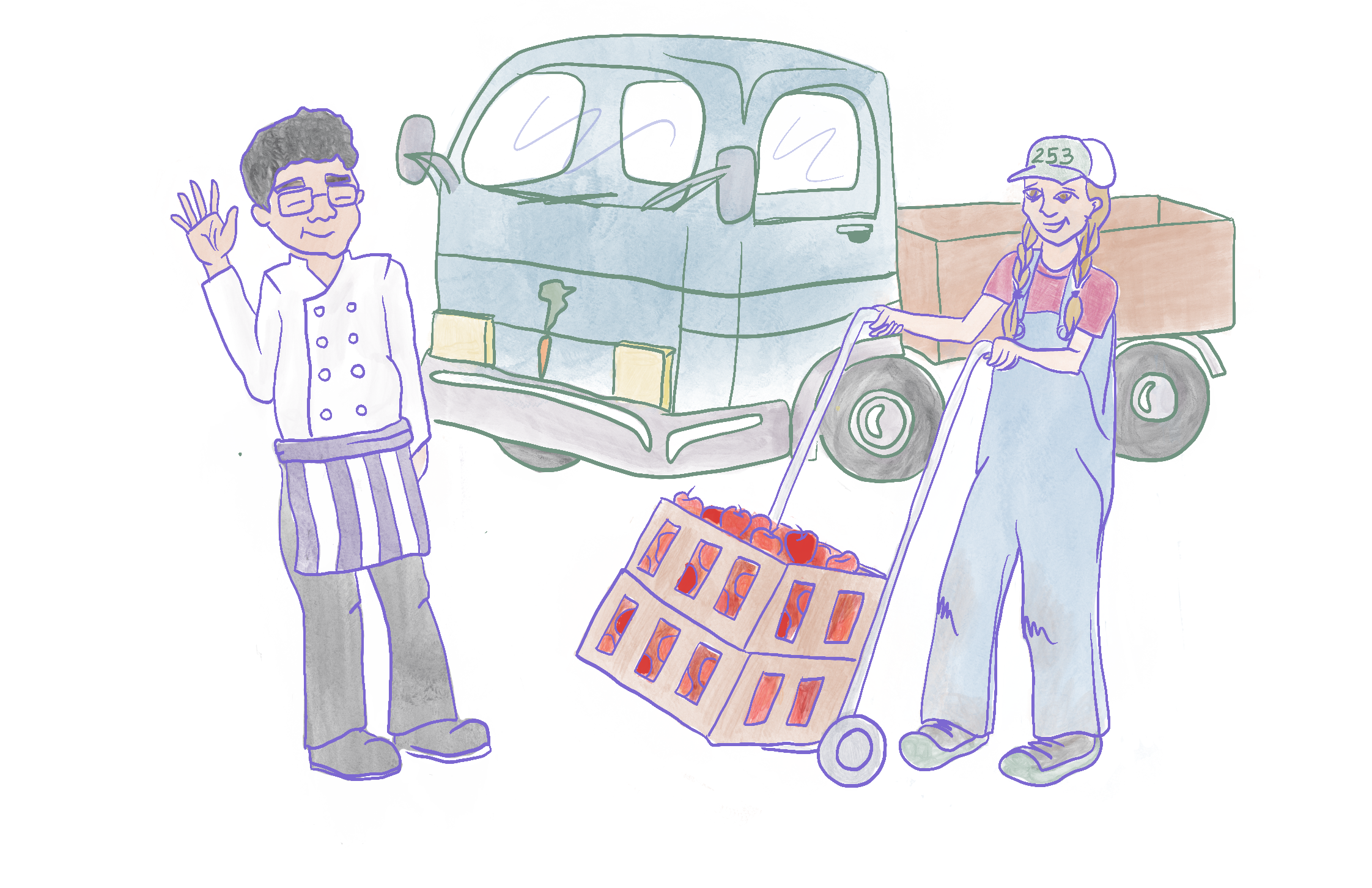
“Honestly, so great! I’m learning so much about tree care (23). And I dropped off fresh apples and plums at the community food hub (34) today. I hadn’t been there before. Whatever they were making in the cooking class smelled delicious. I’m so hungry now!”
“Well, perfect timing!” replies Jo, seeing María walk in.
“Sorry I’m late,” María apologizes, “I was trying to get a few more sign-ups for tomorrow’s beach clean-up (4) after class. Are you coming?”
“I can’t. I’m interpreting at that emergency preparedness seminar (43) for the group I’m working with through Tacoma Community House (1).” says Jo. “Next time though!” The server arrives and all three look up, still clueless as to what they’ll be ordering.
STORY 3: WORK DAY BY THE PUYALLUP RIVER
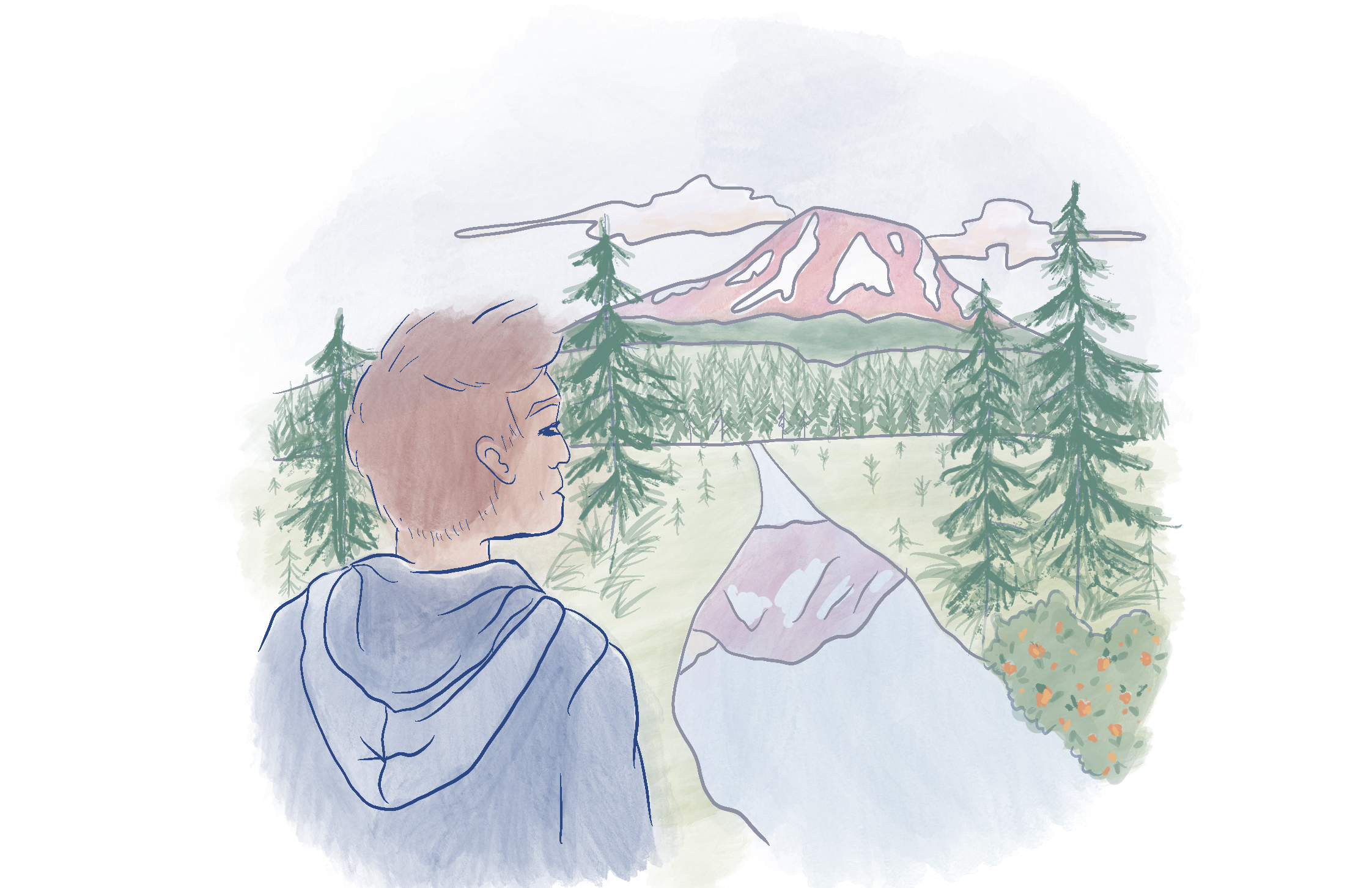
Carlos shuts the back of the truck closed, stirring
the birds in the fir tree nearby. It’s cold out but it’s
his favorite time of the day – prepping the crew trucks just as the sun is starting to rise. Today is a special day too. They have new crew members joining them, recent grads from the TCC landscaping and restoration program (32, 33). Julia, the crew manager, was able to hire more members due to the new green jobs incentive the City is offering (35).
It’s been almost 10 years since Julia and Carlos first visited the site as new crew members themselves. Julia will lead the new crew through a tour of the site and get them started planting salmon berry and sedge along the river bank (39). Carlos is most excited for their Puyallup Watershed restoration partners (7) to join him to talk about water management and flood and erosion control (45). He wants his new crew to understand the land they are on. Just beyond their site is an organic farm (3, 8). They benefit from clean water for irrigation from the river and are protected from winter floods by the habitat restoration and bank stabilization the crew is working on (44). Last year Carlos worked with the farm owner to make sure their nutrient runoff isn’t affecting the river ecosystem downstream and so now they’re a recognized green business (26).
Carlos tosses Julia a set of keys. The trucks pull out of the lot and head to the river. Carlos watches Mount Tahoma turn pink with the rising sun and feels ready for the day ahead.
STORY 4: COFFEE AT THE COMMUNITY CENTER
Ray has moved his usual Tuesday morning coffee with friends to the Peoples Community Center,
a cooling center (41),
on this hot and smoky 94°F August day. He chats with Leilani and Rob over
a game of cards. They discuss their weeks.
Ray’s grandchildren were just visiting from across
town. Conversation keeps returning to the heat and the wildfires in the region. Ray shares that his
grandson, Osmar, has asthma as he pats the filter fan (42) beside him. City staff were handing
them out to homes that don’t have air filters. They said this building was retrofitted a few years
ago to be a space with clean air and an all-electric heating and cooling system (15). They also said
that with his fixed income he could qualify for a ductless heat pump, which can provide home
heating, cooling, and air filtration. He might just do it, since summers are hotter than they used to
be.
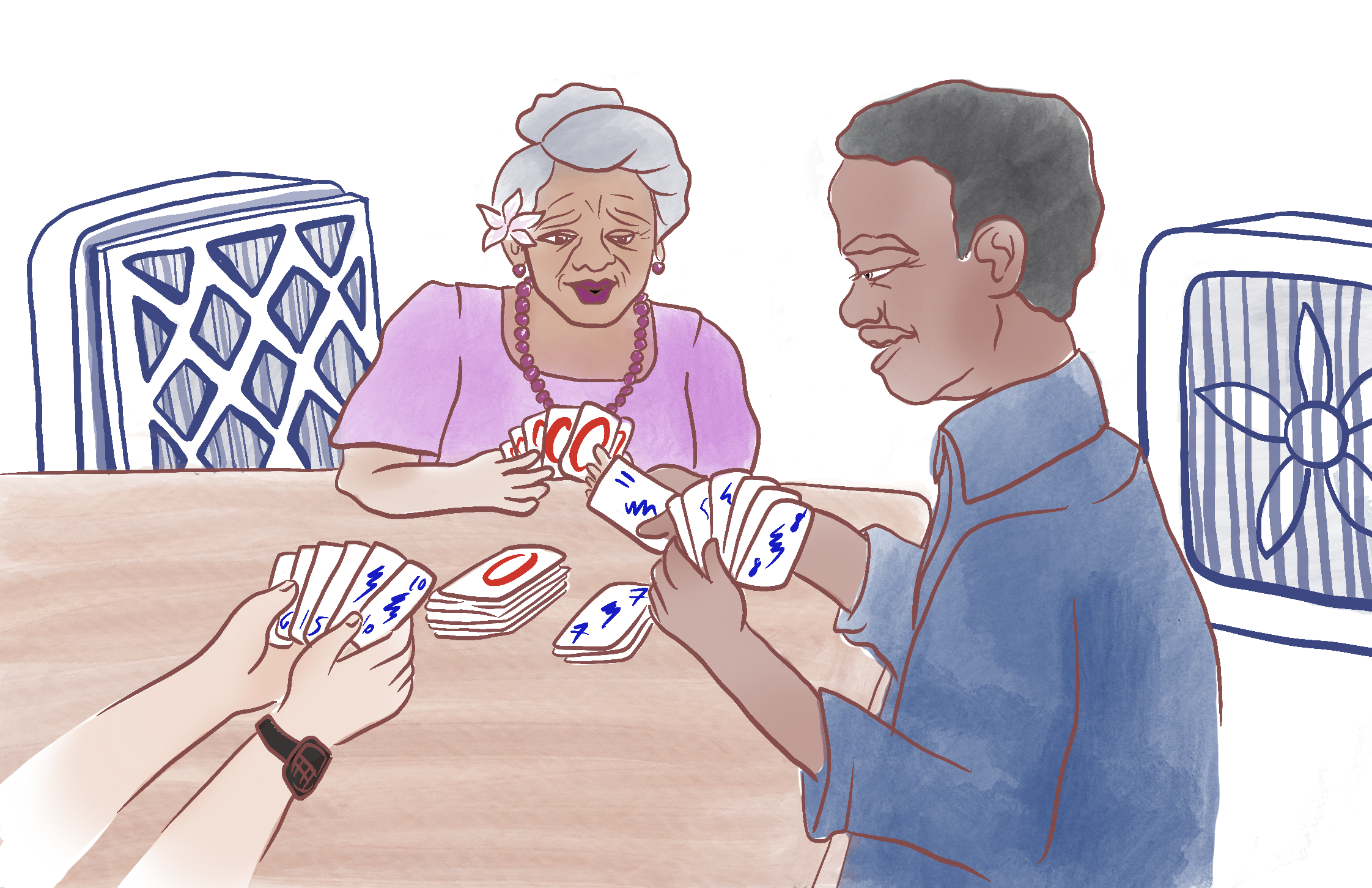
Leilani shares they have a barbecue planned this weekend if the weather improves and the burn ban is lifted by then.
With the heat and smoke, they plan to stay overnight in the cooling center. In a way, it reminds Rob of the summer camps he used to attend – food, social activities, and a recent blockbuster will be playing on the big screen in the community hall after dinner.
STORY 5: FIRST DAY ON THE JOB
Akash arrives to his first day on the job at Container Services Terminal (CST) with a mix of excitement and anxiety. His mom worked in the tideflats for years, serving on teams that moved countless containers from the huge oceangoing vessels that come to Tacoma. He takes pride in the idea that he will help bring food and cargo to and from Tacoma and the wider region.
His supervisor, Theresa, explains that the organization has been around since 1939. It values not only its reputation as a reliable business partner, but as a responsible company with its roots in Tacoma. It has accomplished big reductions in emissions through innovation in its operations and has helped its shipping partners in truck and rail transportation reduce their emissions too. And, it has a commitment to reduce emissions another one-third by the end of the decade. To meet their goal, Theresa represents CST as part of a Tacoma sustainable manufacturing and industry collaborative (37, 38), which is a group of Tideflats businesses developing a cooperative approach to clean fuels (6, 46) and delivering port services to build their competitive edge internationally.
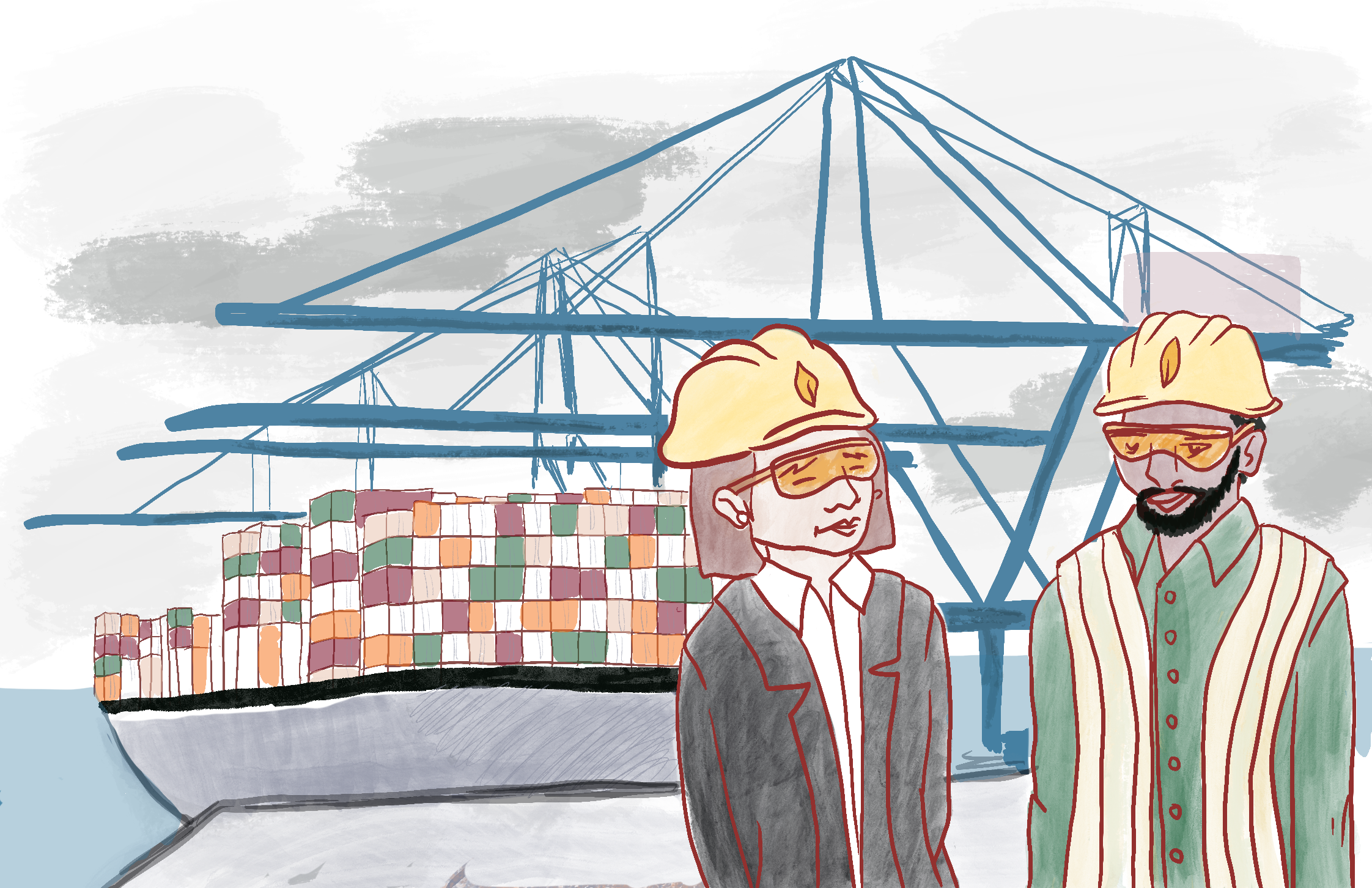
Container Services Terminal and the Port of Tacoma are committed to getting to net zero by 2050 to meet the commitments established in the Northwest Ports Clean Air Strategy. The company recently deployed shore power at its terminal so that vessels can turn off their engines while they are at berth and now they are working with the Port of Tacoma and Tacoma Power to explore innovate ways to deploy zero emission cargo-handling equipment. This will reduce emissions and noise, creating a safer, better working environment for waterfront workers. CST, in partnership with the City and other regional organizations, is helping shape national green port policy now (5). She expects that Akash can follow in her footsteps someday, helping to maintain and improve Evergreen’s services into the next generation. Working at CST means Akash can go home at the end of the day with good pay and satisfaction that he helped deliver the day-to-day goods everyone depends on.
“This work is profitable without sacrificing fair pay and responsible environmental practices, and we want you to hold us to it”(37). Akash nods and smiles.
STORY 6: SATURDAY'S HOME PROJECTS
Sam is around the house for the weekend. There’s plenty to get done, and truth be told she likes home projects. The to-do list: add a garden bed, plant giant sequoia and blueberry seedlings from the Lincoln High School plant sale, and walk the contractor through the house energy audit. Sam begins with the garden bed. Reusing old wooden fence boards (29), she digs into the soil using a shovel from the Tacoma Tool Library (2). Topping the new bed off with TAGRO soil amendments she moves onto places marked yesterday around the yard for the seedlings: two sunny spots with plenty of root space away from the fenced property line and other structures for the sequoias, and a place with partial sun near one of the cherry trees for the blueberry bush. With all the potential new produce, she might sell some of her extra fruits and veggies to neighbors (8).
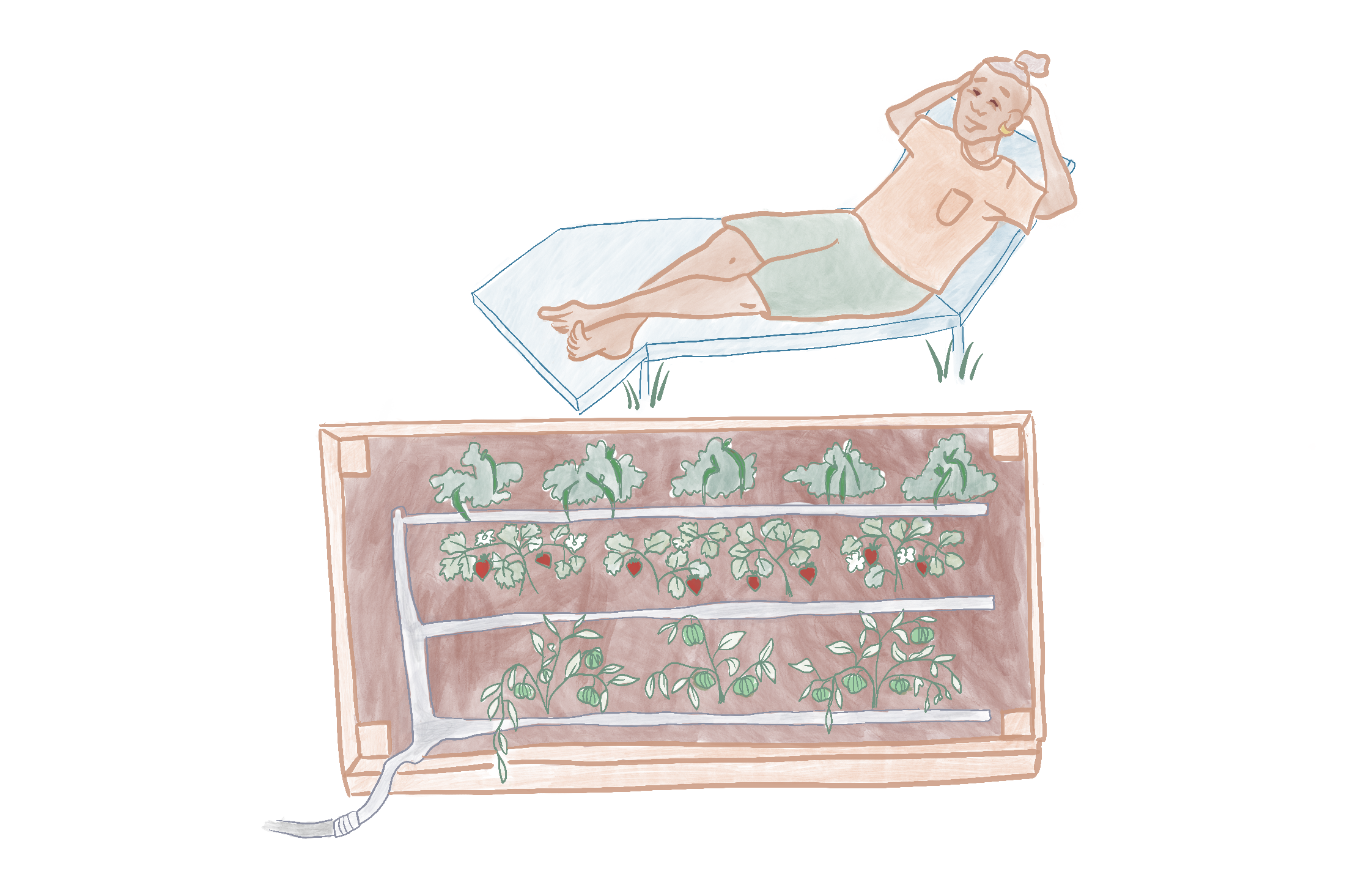
Right on time at 1:00pm, the contractor,
LaTasha, rings the doorbell. LaTasha asks about the insulation in the ceiling and walls, and then about the old cadet heaters. After touring the house LaTasha shares her notes on potential energy efficiency improvements and the additional comfort and bill savings they would bring. She provides a website where Sam can find affordable City loans and incentives for them (14). “If you’re thinking of selling some day, improving your home’s energy score (16) would really add some value” LaTasha explains. Sam says she’ll think about LaTasha’s recommendations, but that she loves living in Lincoln and isn’t thinking about selling soon. “Those upgrades will help keep you happy and comfortable here for years, too! By the way, I was trained in home energy audits while still in high school at Lincoln!” LaTasha responds. After chatting about the neighborhood, it’s time for LaTasha to leave. Thanking her, Sam returns to the backyard. She sets her drip irrigation lines (25) on a short timer, glances at the young beans, strawberries, and tomatillos in the old garden bed, and then sits back in a lawn chair. With everything done, Sam is ready for a lazy Saturday evening in what is left of the springtime sun.
STORY 7: WORKING TOWARD OPENING DAY
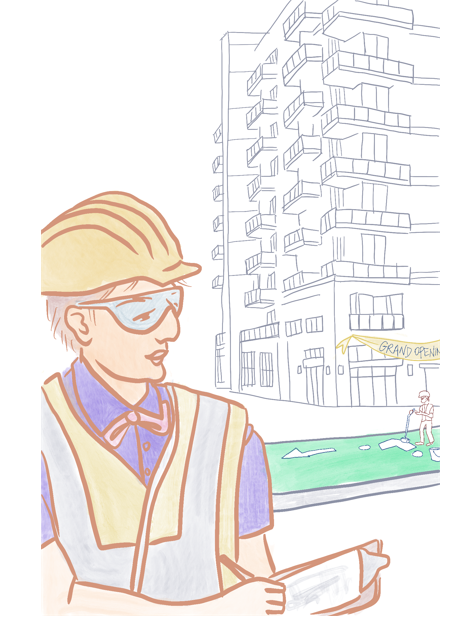 AJ is the property manager at Pacific Avenue Station. With its 4 floors of housing above street-level businesses, Pac Ave Station is the tenth building they have managed since graduating from UWT in 2017. It’s also the one AJ is most excited about. To develop this building, the regional company asked AJ to explore the latest construction standards and opportunities in Tacoma. He recommended durable, low-carbon green building materials (28), efficient technologies, and the inclusion of affordable housing units (13), which helped the company access financial incentives and better serve the neighborhood. Working closely with the City and Spaceworks, some of the commercial space downstairs has been set aside for local start-ups (36). Sitting on the #1 bus line, residents will be able to ride right into downtown for work, school, and weekend fun (17). This location means easy connections across town for residents and business tenants, and consistent interest in the units will mean low turnover costs for the company.
AJ is the property manager at Pacific Avenue Station. With its 4 floors of housing above street-level businesses, Pac Ave Station is the tenth building they have managed since graduating from UWT in 2017. It’s also the one AJ is most excited about. To develop this building, the regional company asked AJ to explore the latest construction standards and opportunities in Tacoma. He recommended durable, low-carbon green building materials (28), efficient technologies, and the inclusion of affordable housing units (13), which helped the company access financial incentives and better serve the neighborhood. Working closely with the City and Spaceworks, some of the commercial space downstairs has been set aside for local start-ups (36). Sitting on the #1 bus line, residents will be able to ride right into downtown for work, school, and weekend fun (17). This location means easy connections across town for residents and business tenants, and consistent interest in the units will mean low turnover costs for the company.
Pac Ave Station is on track to open in two months. AJ watches from the window of a nearly
finished unit as construction trucks carry away recyclable construction materials (27) that will be
sold and reprocessed into new construction materials. A team of City contractors works across the street. Beside a cement truck, they pour a new low-carbon concrete mix into place for a new
sidewalk and transit stop (30, 31). AJ heads downstairs and into the bustle of the neighborhood –
it's lunch time.